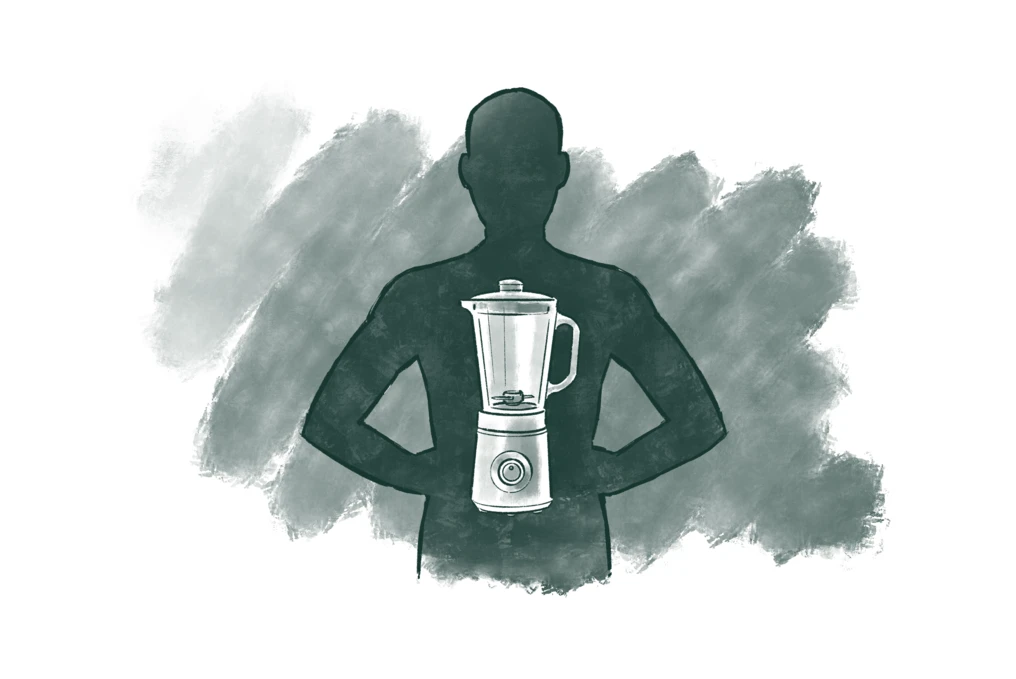Let’s say you had a slice of your favorite bread for breakfast today. This bread is made from grains like wheat or rye and contains carbohydrates, which give us energy to start our day.
Carbohydrates are like big, complicated puzzles made of sugar molecules. They're too big to be absorbed by our blood directly to give us energy.
That's where enzymes come in! There are more than 75,000 enzymes in our bodies. One of these little fellas, called salivary alpha-amylase, is in our saliva.
Enzymes at work: Let’s learn through some examples ( Enzyme article 2:2 )

When you take a bite of bread and start chewing and grinding the bread into a pulp, your saliva mixes with the bread and the salivary alpha-amylase starts working. It's like a skilled worker who gets the job done - quickly and effectively
The salivary alpha-amylase facilitates the quick reaction between our saliva and the big, complicated puzzle of carbohydrates in the bread. The enzyme breaks down the carbohydrate into smaller parts transforming the carbohydrates into much smaller pieces of easily digestible sugar.
After this happens, the broken-down carbohydrates in the bread travel as it is with the pulped bread from our mouth through our digestive system. When this reaches our intestines, another similar enzyme is released from the pancreas, called pancreatic alpha-amylase. This enzyme transforms the already broken-down carbohydrates into even much finer particles – so small that they can be easily absorbed into our blood and provide us with the energy we need to fuel our day.
And that’s how the bread we ate in the morning turned into energy inside our bodies. This is just one of the enzymes that help in digesting food. There are many more.
Let’s continue with another example of the essential role of enzymes in our body:
So, imagine yourself jogging away on a lovely spring day, filling your lungs with fresh air and enjoying the sunlight – but suddenly you trip over something, fall down and scratch your knee. Darn it, some blood oozes out!

The catalase enzymes speeds up healing reactions in your body, when you for instance scratch your knee and bleed.
But fear not, for your body springs into action to heal the wound. As an instant reaction, your body dispatches a chemical called hydrogen peroxide along with some soldiers called white blood cells to the accident scene to prevent any harmful bacteria from entering your body. So far, so good.
On the other hand, too much hydrogen peroxide is bad, as it could potentially lead to cellular damage. So, what does your body do? It tightly regulates the levels of hydrogen peroxide by dispatching an enzyme – Catalase – basically, the hydrogen peroxide's worst nightmare, as enzymes’ purpose in life is to transform one chemical into another at extreme speed.
In this case, the catalase enzyme speeds up a reaction that transforms the harmful hydrogen peroxide into two new products – water and oxygen. These are just two functions that enzymes perform in your body (digestive aid and wound healing). There are thousands of other functions being performed by enzymes in your body, 24/7/365.
Have you thanked your enzymes today?
7 things you probably didn’t think about!
As you go about your day, countless enzymatic reactions are taking place in your body to ensure its proper functioning. Here are some examples of what enzymes might be doing right now:
Digesting food
Enzymes in your digestive system are breaking down the food you've eaten into smaller molecules like sugars, amino acids, and fatty acids. This allows your body to absorb and use these nutrients for energy and growth.
Cellular respiration
Enzymes within your cells are involved in cellular respiration, where nutrients are further broken down to produce energy (ATP molecules). This energy is essential for powering various cellular processes.
DNA replication and repair
Enzymes are constantly at work ensuring the accurate replication of your DNA during cell division. If any errors or damage occur in your DNA, repair enzymes are busy fixing them to maintain the integrity of your genetic information.
Metabolic processes
Enzymes are participating in a wide array of metabolic pathways, synthesizing molecules necessary for cell structure, signaling, and regulation. These processes are crucial for maintaining the balance within your body.
Blood clotting
Enzymes in your blood are ready to initiate the clotting process if you get a cut or injury. This prevents excessive bleeding and promotes wound healing.
Immune system function
Enzymes are part of your immune system, helping recognize and eliminate foreign invaders like bacteria and viruses. They play a vital role in protecting your body from infections.
Detoxification
Enzymes in your liver are involved in detoxifying harmful substances, ensuring that your body can eliminate toxins and maintain a healthy internal.
These processes are ongoing and essential for your survival. Enzymes are like the behind-the-scenes workers in your body, diligently carrying out tasks to keep everything running smoothly.
The natural world is full of enzymes

When you throw plant waste in compost, the bacteria, fungi and other microbes degrade them. They do this with the help of an enzyme called Cellulase.
Not only humans are home to magic enzyme factories. Plants, animals, and microbes (bacteria, fungi, algae, etc) also produce their ammo of enzymes for survival. Like in humans, enzymes ensure everything in the plant and microbial world also runs smoothly.
There is a set of enzymes called Proteases, which help plants in multiple ways – from fighting off pests and infections to generating proteins for survival (yes, even plants need proteins!), plant growth, and regeneration.
Even microbes have their enzyme squad too!
We all know about composting. Some of us even compost our household green waste to generate manure for the garden. But what exactly happens in a compost pit to all the vegetable peels, fruit seeds, and other plant waste that you throw away?
When you throw plant waste in compost, the bacteria, fungi and other microbes degrade them. They do this with the help of an enzyme called Cellulase. Remember how tough is a watermelon or pumpkin hide? Cellulase can cut through the tough exterior of plants, which is made of a natural, tough material called cellulose. But cellulase is up to the challenge. It can break down cellulose, much like how a skilled carpenter cuts through wood with a saw.
This article is part of The biosolutions bulletin. Want it in your inbox every month?
Once cellulase gets to work and starts snipping away at the cellulose, it weakens the plant's defenses, allowing the microorganisms to dive in and feast on the softer, more digestible parts inside. And as these microorganisms go about their business, breaking down organic matter, they create compost – a dark, crumbly substance that's like gold for gardeners, packed with essential nutrients that plants love.
Then there are the bacteria that can take nitrogen from the air and convert it into a form that the plants can absorb for their survival. When we eat those plants, we get our fix of nitrogen from the food. This “fixing” of nitrogen from air into a consumable form by bacteria is possible due to an enzyme known as Nitrogenase.
Interestingly, the name of an enzyme typically hints at the substrate it acts on and the type of enzyme it is, as we have seen in above examples.
As researchers discovered that enzymes play such an important role in the world, they dug further to unearth the secrets of enzymes and their power to transform one thing into another; a totally new product. And they realized that human beings can unlock the power of enzymes to make life easier and the world a better place.
There are rarely any problems that enzymes cannot help humans deal with – ranging from something as mundane as keeping clothes clean to dealing with climate change. Yup, you read it right, even climate change!
Let’s have a closer look at that!
Unlocking the transformative power of enzymes for humanity
Although enzymes are everywhere around us and inside us, it was only in the 19th century that scientists determined their existence, identified their functioning, understood their sources, and came up with the term ‘enzyme’.
It originates from the Greek words "en" (meaning "in") and "zyme" (meaning "leaven" or "yeast"). The term was coined in the 19th century to describe substances found in living organisms that facilitate and accelerate chemical reactions without being consumed in the process.
Researchers found out that enzymes are the reason behind many day-to-day things that humans have been doing for thousands of years – baking bread, brewing beer, making yogurt or preserving food through fermentation.
Once this was discovered, there was no looking back. Enzymes are now a reason why life is easier for us, why we get to eat some delicious foods, and how we have solutions to deal with some of the serious global challenges. Let’s now take a look at some examples:

Keeping clothes clean and fresh, keeping dishes spick and span:
Keeping clothes clean and dishes sparkling has been a perpetual challenge, but the transformative power of enzymes has revolutionized the effectiveness of detergents and dishwashers. By identifying the most effective enzymes, detergent manufacturers began incorporating them into their products, targeting even the toughest stains, including oil and grease, on clothes and dishes.
This shift is particularly crucial considering the substantial environmental impact of detergent residues entering waterways and ecosystems. Today, a substantial portion of detergents available in the market harness the power of enzymes. Incidentally, you can save a lot on your energy bill by washing at 30 C/86 F rather than 40 C/104 F, thanks to enzymes.
Getting to eat yummy bread
Bread is a good source of carbohydrates, providing energy for the body, and it stands as an elemental source of sustenance worldwide. It also adds a huge yum quotient to our lives. We can thank the intricate interplay of enzymes during dough fermentation and baking for that. Enzymes transform simple ingredients into a symphony of sensory delights that contribute to the unique taste, aroma, and mouthfeel that characterize freshly baked bread, making it a universally cherished culinary experience.

Enzyme-based cleaners contain enzymes that target organic compounds.
Pet stain and odor removal
We all love our furry friends. But with having pets at home comes the challenge of ensuring the house is clean, hygienic and odour-free. Many cleaners that you use to remove pet stains and odors from the carpets, upholstery, and other surfaces in your house contain enzymes.
Pets often leave behind urine, vomit, and faeces, which contain biological materials that produce unpleasant smells. Enzyme-based cleaners contain enzymes that target these organic compounds, breaking them down into smaller, odourless molecules. This helps eliminate stains and odors at their source, leaving your home smelling fresh and clean.
Global challenges solved by enzymes:
Helping agriculture overcome the challenges of climate change
Climate change poses significant challenges to agriculture worldwide, affecting crop yields and threatening food security. As temperatures rise and rainfall patterns become erratic, farmers face mounting pressures to adapt. As per estimates, the impacts of climate change on agriculture could threaten the world’s food security and push 180 million more people into hunger. However, through meticulous research, the potential of enzymes in agricultural practices has emerged as part of the promising solution.
Enzyme-based biosolutions offer a means to enhance crop resilience and productivity in the face of climate change. These innovative solutions leverage the transformation superpower of enzymes to improve plant growth, nutrient uptake, and stress tolerance. By enhancing soil health, water efficiency, and nutrient utilization, enzyme-based biosolutions empower farmers to mitigate the adverse impacts of climate change on crop yields.
Ensuring enough protein for the world's growing population
The world's population is projected to reach 10 billion by 2060 and the demand for proteins will soar. Fortunately, enzyme-based biosolutions offer a sustainable alternative to meet the world's growing protein needs by creating new possibilities for nutritious protein sources. Such proteins emit 90% less greenhouse gases than the livestock industry while providing high-quality nourishment to us, be that replicating a dairy protein without involving animals or creating protein-fortified food and beverage products with specific nutritional or health-enabling benefits.
Restoring polluted ecosystems
In many places across the world, natural resources like water bodies and soils are heavily polluted. With meticulous studies, researchers have discovered enzymes that can break down and transform pollutants into harmless products. This is called ‘bioremediation’ and offers a sustainable and environmentally friendly approach to restoring contaminated sites and ecosystems.
In conclusion: We need to embrace the enzyme revolution
Enzymes have helped humans weave a fascinating tale of innovation and sustainable transformation but have remained the overlooked pillars of our existence. Now scientists, researchers, and corporations are unravelling newer and more innovative uses of enzymes to make the planet a better place for all living organisms. As we delve deeper into the mysteries of enzymes and unleash their potential across various sectors, we stand at the brink of a revolution led by enzymes and the biological alternatives to chemicals – biosolutions – that they enable.

Fermentation in an industrial setting where microbes multiply rapidly and produce enzymes.
Enzymes in an industrial setting
You may wonder how enzymes are made in an industrial setting.
We have learned that all living things make enzymes, and seen from an industrial point of view, microbes would typically be the source as they are very effective enzyme producers.
To get critical mass, carefully selected microbes are fermented in large tanks with high oxygen concentrations and a rich broth of nutrients. This is the fermentation medium, or “food” for the microbes.
The microbes multiply by millions, and as they break down and consume the nutrients, they produce the enzymes, which are harvested to be used for a rich variety of purposes across industries, agriculture and healthcare.

ⓘ This article is a part of The biosolutions bulletin, Issue #2. Discover the rest of the articles from this issue below:
Enzymes: Catalysts of change, masters of transformation
Dive into the world of biology and unravel the mysteries of enzymes.
Digesting the problem: Enzymes chew through plastic pollution
Explore the potential solution of converting emissions from fossil fuels back into fuel.
What is a biosolution?
Microbes and enzymes are tiny but mighty agents of change. For billions of years, they’ve enabled transformation in all living things through microbiology.

What are biosolutions? Where do they come from?
How do they work? What would the world look like without them?
Get the answers to these questions and more from the monthly biosolutions bulletin. Whether you’re an expert who wants to keep on top of the latest innovations or just starting to learn about biosolutions, we’ve got you covered.
With stories ranging from the role of biosolutions in food security to how they enable NOMA-style dining experiences, there’s something for everyone.
Don’t miss out on the latest news about how biosolutions better our world. Sign up to get the biosolutions bulletin delivered directly to your inbox.
One more step…
To complete the get in touch form or sign up, please click on the button below to enable cookies.